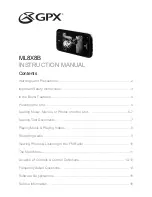
2
Contents
Introduction
Introduction .............................................................................................. 2
Important safety instructions .................................................................. 3
Limited warranty ...................................................................................... 4
Rear panel connections........................................................................... 5
Front panel controls................................................................................. 6
Display functions...................................................................................... 6
Remote control......................................................................................... 7
Operating instructions ............................................................................. 8
Filters ........................................................................................................ 10
Custom installation use........................................................................... 11
Troubleshooting........................................................................................ 11
Technical specifications........................................................................... 11
Thank you for purchasing this Cambridge Audio Azur 550C or 650C CD
player. Like all Cambridge Audio products, the 550C and 650C adhere
to three core principles – stunning performance, ease of use and
incredible value.
Developed as part of our on-going research and development regime,
including extensive listening tests, we have incorporated many subtle
tweaks and improvements to our circuits, components and layouts in the
pursuit of our passion for sound quality.
We have developed a completely new S3 servo for these models. The S3
is our third generation proprietary audiophile servo solution and draws
on all our experience with this technology. It utilises the latest double-
sided surface-mount technology for ultra short signal paths with freedom
from wire links. It can dynamically adjust the focusing, tracking and
output level of the laser in real-time, allowing for maximum retrieval of
the digital information with extremely low data jitter. This is complemented
by our use of a highly accurate master clock oscillator and very carefully
designed impedance-matched clock buffering schemes. We have also
incorporated support for CD-text to enhance those discs that feature it.
For the critical Digital to Analogue converter stages, we have also moved
to double-sided surface-mount to remove wire links and shorten all signal
paths. New Metal Electrode Face resistors, polypropylene caps and
custom-made electrolytic capacitors have all been used for their superior
sound quality.
Both models employ the WM8740 24bit/192kHz-capable Digital to
Analog converter from Wolfson Microelectronics. This very high quality
part is coupled to our proprietary Double Virtual Earth Balanced filter
topology which has been revised and re-calibrated for Bessel coefficients
in both the 550C and 650C. In line with all our models, a toroidal
transformer is fitted to provide lower noise and less waveform distortion
for quieter PSU operation.
The 650C differs from the 550C in using a pair of WM8740 24bit/
192kHz-capable Digital to Analogue converters implemented in a dual
differential configuration. Since each channel has its own DAC to process
information, completely separate and symmetrical analogue filter circuitry
can be implemented.
The 550C features a Three-Pole Double Virtual Earth Balanced filter
topology with new Bessel co-efficients. The 650C features an even more
sophisticated Four-Pole Dual Differential Double Virtual Earth Balanced
version of this filter. This means that the DAC for each channel features
two fully balanced outputs, each of which are then summed in a third
order virtual earth balanced filter stage. A further first order balanced
filter stage sums the balanced outputs of the earlier filter stages. This
double-balanced configuration largely rejects noise and distortion
products present in the DACs and filters themselves to produce an
unprecedented level of performance.
These models are amongst the first to feature a new casework design
with a thicker braced front panel, more rigid wrap-over lid assembly and
dual-layer damped feet, all of which contribute to better control of
resonance. Another highlight is an eco-friendly low power (<1W) standby
circuit. This circuit completely powers down the CD player circuits in
Standby mode yet is itself totally isolated when the CD player is on, thus
having no effect on sound quality.
Your CD player can only be as good as the system it is connected to.
Please do not compromise on your amplifier, speakers or cabling.
Naturally, we particularly recommend amplification from the Cambridge
Audio Azur range, which has been designed to the same exacting
standards as our CD players. Your dealer can also supply excellent quality
Cambridge Audio interconnects to ensure your system realises its full
potential.
Thank you for taking the time to read this manual; we recommend you
keep it for future reference.
Matthew Bramble
Cambridge Audio Technical Director
and the 550C/650C design team
Make sure you register your purchase.
Visit: www.cambridgeaudio.com/sts
By registering, you’ll be the first to know about:
G
Future product releases
G
Software upgrades
G
News, events and exclusive offers plus
competitions!
This guide is designed to make installing and using this product
as easy as possible. Information in this document has been
carefully checked for accuracy at the time of printing; however,
Cambridge Audio's policy is one of continuous improvement,
therefore design and specifications are subject to change
without prior notice.
This document contains proprietary information protected by
copyright. All rights are reserved. No part of this manual may be
reproduced by any mechanical, electronic or other means, in any
form, without prior written permission of the manufacturer. All
trademarks and registered trademarks are the property of their
respective owners.
© Copyright Cambridge Audio Ltd 2010






























